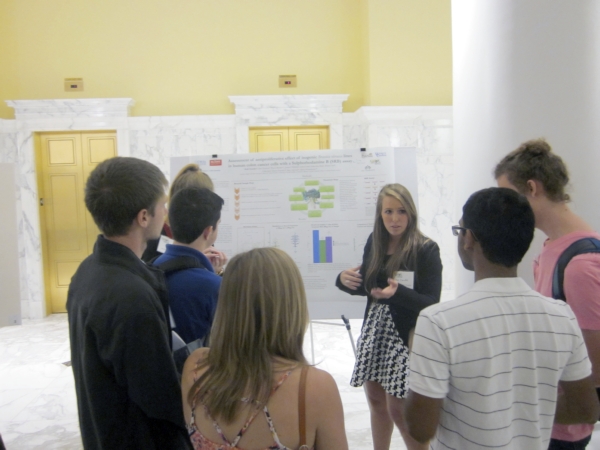Catawba students shine during summer internships at N.C. Research Campus
Published 12:00 am Thursday, August 27, 2015

- Holli Chandler presents her poster on the effects of broccoli on colon cancer cells. Submitted photo
Catawba College senior Holli Chandler, a chemistry major from New London, has a new appreciation for broccoli and how its extracts can impact human health.
Chandler was one of six Catawba College students among the 30 undergraduate interns who participated in the Plant Pathways Elucidation Project (P2EP) at the N.C. Research Campus in Kannapolis this summer.
Chandler was a member of the Nutritional Implications Anti-Cancer Research Team. She collaborated with Claire Thetford of N.C. State University to create the poster that took first place in the scientific poster competition held at the conclusion of the summer research.
“I came in not expecting to get results from our internship experience, and we got some results, and that was awesome,” Chandler shared. “We were trying to find which broccoli extracts have the most prominent anticancer effects on human colon cancer. We were able to show a consistent effect in killing cancer cells at 200 mg/ml of broccoli extract treatment.”
But perhaps as important to Chandler as the results she achieved from her research was her fledgling skill in “being able to take science and research and break it down for others to understand and benefit from.”
Other Catawba students participating in the third year of the P2EP included Matthew Jordan-Steele of Lexington; Johnathon Boles of Salisbury; Audrey Hoffman of Dracula, Georgia; Taylor Parker of Mount Ulla; and James Lohr of Salisbury.
Jordan-Steele was on another intern team that took second place in the scientific poster competition for his presentation.
The summer internship experience “helped improve my skills of working in a group and presenting,” said Jordan-Steele. It also offered this senior biology major “another aspect of research that I’d never thought about – statistical research.”
Jordan-Steele shared that the internship taught him a lot about genetically modified organisms and employment in the industries developing these.
Boles, a biology major pursuing minors in accounting and chemistry, said his intern team evaluated wound-healing properties of oats, or more specifically, “oat-healing property in vivo.”
“A lot of folk remedies are related to oats, but we asked how can we take that and back it up with science. Once we discover what promotes wound healing, we need to find those related genes in the oats and try to pump that up,” Boles explained.
“I see where science and business intersect, and I now understand how that affects the general population,” he said. “Another lesson that I learned during my time at the research center was that there are so many variables to be accounted for in research – it’s like a puzzle. That’s why we have bioinformatics – it culminates and organizes all of the data points so that we can make sense of our data and draw conclusions from our data.”
“I want to go into medicine and this is the most applicable and relatable part of nutrition to medicine. I can clearly see the end step,” Boles added.
Parker and Hoffman were on an intern team that focused on beta-glucan, found in all cereal grains and at higher concentrations in oats and which has been proven to reduce LDL cholesterol. Members of this team analyzed data from the oat genome to identify candidate genes responsible for the synthesis of beta-glucan and two phenolic compounds that are known to have human health benefits.
“I haven’t taken genetics at Catawba,” Hoffman, a biology major with a double minor in secondary education and chemistry, shared, “and I was definitely very intimidated when the summer began. I thought it was way over our head, but our mentor was terrific. I feel more confident taking future courses with this experience under my belt.”
Parker, who is double majoring in biology and environmental science, agreed, adding, “I can definitely take genetics by storm. We can also talk to people now about complicated data in a way they can understand.”
This is the third year that Catawba College students have participated in P2EP research, and their efforts have focused on blueberry, broccoli, oat and strawberry. Intern teams are guided by a lead researcher and a graduate mentor. At the end of their summer internship, each team presents a five-minute synopsis of their research. They also work together to prepare scientific posters that are submitted into a poster competition judged by representatives from academic and industry partners of Research Campus.



